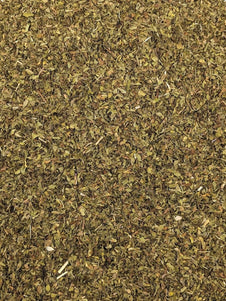
Spearmint Tea
13 reviewsSpearmint Tea
13 reviews- In stock, ready to ship
- Inventory on the way
Country of Origin may differ from what is shown above.
Culinary Uses
Organic dried spearmint tea has a cooling effect on the palate and like most mints, it may be used for whatever culinary purpose you desire. Spearmint works well with peas, vegetable and fruit salads, or meat, poultry and fish dishes. It does equally well with desserts, herbal tea and cold drinks. In particular, Spearmint is known for its role in preparing the alcoholic drinks mojito and mint julep usually added fresh, but if you don’t have fresh spearmint growing, you can make a Spearmint syrup to add to drinks of desserts.
Spearmint Syrup
1 tablespoon dried spearmint
1 cup sugar
1 cup water
Put the dried spearmint and water into a saucepan, bring to the boil and turn heat off, let sit for 10 minutes and strain out the spearmint. Put the sugar and infused water back into the saucepan and bring to the boil, simmer gently for 2 minutes, cool and bottle.
Medicinal Uses
Most mints have a history of traditional medicinal or herbal use for fevers, headaches and minor ailments. These plants are often used as a digestive aid in the form or herbal tea. The main active constituent in Spearmint is carvone, which provides the distinctive aroma. Traditionally, Spearmint was considered antifungal, antibacterial, antiviral, antiseptic, mildly analgesic, antispasmodic, carminative, effective for stomach complaints, used for regulating menstrual cycles, to treat headaches and insomnia, as an insecticide, and as a restorative and stimulant.
Today, Spearmint may be used as an herbal tea and is useful for repelling insects and easing the itch or pain from insect bites. It may also be used to treat minor skin irritations or wounds due to its antiseptic properties. Minor relief may be obtained for swelling due to bruises or arthritis. Most commonly, Spearmint tea is used like many other mints as a digestive aid, as a calming relaxant or to assist with insomnia and headaches. Medicinal quantities should be avoided by pregnant women and must not be given, or placed next to the face of babies and young children, due to the potential for breathing difficulties associated with menthol. Spearmint contains less menthol than peppermint and other mints.
Other Uses
Spearmint is used to flavour toothpaste, mouthwash, toiletries, confectionary and add an aroma to some shampoos or soaps.
All information provided on this website is for informational purposes only. Please seek professional advice before commencing any treatment.




